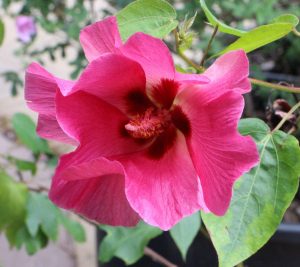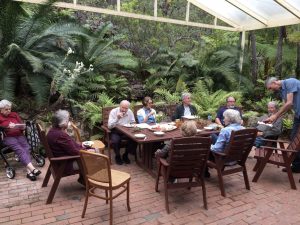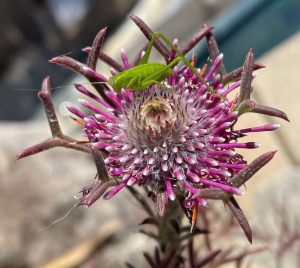Australian Plants for Containers Study Group Newsletter No. 39, March 2022

Some new cultivars of native hibiscus are featured, including Gossypium ‘Flirtatious’. Hibiscus are rewarding to grow in pots, where their soil requirements can be satisfied and they can be protected from frost. Member Karen Nicoll has successfully grown a variety of native food plants in pots in her Newcastle garden, with species including Backhousia myrtifolia (Cinnamon Myrtle), Tasmannia lanceolata (Mountain Pepperberry) and Cymbopogon ambiguous (Native Lemongrass). Member Jane Fountain’s Qld garden is dominated by 30+ m eucalypts, which pull as much moisture as they can from the ground. So she has worked out that the only way for little plants to thrive is to have them in a pot, which she buries in the ground, with plastic lining the hole to prevent the eucalypt roots from finding their way into the pot through the drainage holes.
Fern Study Group Newsletter No. 150, February 2022

Ferns are usually thought of as delicate plants, susceptible to desiccation and destruction by bushfire. However those species that grow in highly fire-prone environments, such as the sandstone country of the Sydney Basin, have evolved mechanisms that allow them to resprout after even the most severe of bushfires. The extensive bushfires of 2019-20 have provided the opportunity to observe these ferns and how they return after a fire. Some species have rhizomes/roots that are protected below the soil surface and allow them to readily resprout. Such species include: Lindsaea linearis (Screw Fern), Lindsaea microphylla (Lacy Wedge Fern) and Schizaea bifida (Forked Comb Fern). Other species have thick, fibrous trunks that protect the growing shoots within, allowing them to reshoot following a fire. Such species include: Cyathea australis (Rough Tree Fern) and Todea barbara (King Fern). Other species of fern have been observed to be stimulated by fire (thought to be the smoke) to produce fertile fronds. Such species include Blechnum cartilagineum (Gristle Fern) and Pteridium esculentum (Common Bracken).
Garden Design Study Group Newsletter No. 119, May 2022
The theme for this newsletter is ‘Design for Climate Change’. Ben and Ross Walcott from Canberra have planned for increased rainfall and its potential for soil erosion by collecting surface runoff through a network of carefully constructed ‘natural waterways’, effectively creating onsite water harvesting. While it is generally agreed to select species endemic to your local region, or known to tolerate the local conditions, looking to the future you may have to select species suited to your future local climate conditions. Chris Larkin of Melbourne discusses the wealth of choice in groundcover plants in Australia, with favourites including: Kunzea ambigua prostrate, Grevillea obtusifolia, Pultenaea pedunculata and Hibbertia pedunculata. Practical benefits of ground-covering plants in the garden include: weed suppression, moisture retention, protection of the soil, erosion control and provision of a living mulch.
Grevillea Study Group Newsletter No. 121, February 2022
The SG has recently been expanded, with new chapters starting in South Australia and Western Australia. Alf Stephens, an enthusiastic grafter-horticulturalist, botanical collector and photographer, will serve as the focal point for the SA members, while John Ewing, who works with the WA Herbarium in assessing all the Priority Grevillea species, will coordinate the WA members. A new species, Grevillea speckiana Olde, has been described from a single collection gathered from the Shark Bay area of WA in 1953. It may now be extinct in the wild, but there remains some hope as the area is quite remote.
An interesting talk titled ‘George Caley and Daniel Moowattin: A Scientific Partnership” (available online here) tells the story of the unusual relationship between an Englishman and a Darug man. Caley worked at Kew Gardens in London before being appointed by Sir Joseph Banks as a botanical collector in NSW in 1798. Moowattin was born in 1791 in Parramatta. He was orphaned at a young age and adopted at the age of five by Richard and Mary Partridge. In 1805, Caley took on the young Moowattin as a guide, translator and travelling companion. They travelled extensively together, and Moowattin helped Caley find dozens of different plant species, including many different eucalypts. In 1810, Caley returned to England with Moowattin, who was at that time only the third Aboriginal person to visit England. In August 1811 Sir Joseph Banks requested that Moowattin return home. Shortly after returning home, he left the home he shared with Caley and returned to the bush. In 1816 he was accused of having attacked and raped a 15 year old girl called Hannah Russell. It was decided by those at the trial, which included Samuel Marsden and Gregory Blaxland, that due to his exposure to European culture he could distinguish between right and wrong and therefore could be found guilty. He was found guilty and with his hanging on the 1 November 1816, Moowattin became the first Aboriginal person in NSW to be legally executed.
Hakea Study Group Newsletter No. 78, February 2022
Most of the Hakeas flower in winter/spring, but there are a few which flower in summer about Christmas time with white flowers. They are kippistiana, leucoptera ssp. leucoptera, leucoptera ssp. sericipes, linearis and ruscifolia. The white flowers attract many insects. There are five hakeas listed in the Corymbosa group, all of which are worthy of a place in our gardens: (1) H. corymbosa is known as the cauliflower Hakea, because the upper part of the plant consists of dense foliage and when in flower the white flowers form a dense cover over the foliage. (2) H. eneabba has some resemblance to H. corymbosa, but is not well known. (3) H. cinerea is very attractive, with yellow flowers and ashy green leaves. (4) H. acuminata is one of the rarest of the Hakeas species, and in great need of preservation. (5) H. victoria is confined to the Barren Ranges in the Fitzgerald NP in WA. The most attractive feature of this plant in the wild is that the leaves change from green to cream to red with age, due to mineral deficiencies in the soil.
Isopogon & Petrophile Study Group Newsletter No. 30, March 2022

Isopogons and petrophiles are mostly pollinated by insects, with native bees appearing to be the main pollinator. However leaping insects such as crickets, grasshoppers and katydids (known as orthopterans, have been shown to be able to pollinate plants as well. Orthopterans are not often observed on isopogons and petrophiles; although they offer pollen, these genera lack rewards such as nectar, or strategies to attract pollinators such as a scent. As well as large amounts of pollen, these species provide convenient landing points for pollinators, such as the top of the inflorescence, and finial-shaped pollen presenters which provide convenient holding points for pollinators. It may be that it is the smaller or immature orthopterans which visit isopogons and petrophiles. Observations from members include a grasshopper regularly seen on Isopogon formosus and katydid nymph eating pollen from a Petrophile brevifolia.
Wallum and Coastal Heathland Study Group Newsletter No. 52, March 2022
Australia has 90 described species of mistletoe, yet there appears to be a dearth of records of mistletoe from wallum heaths. SG Leader Allan Carr believes a possible explanation may be that mistletoes can take many years, even decades, to recover from hot fires, and the sites frequently visited by the group have been burnt frequently. Another factor may be to do with the ability of potential observers to recognise and identify mistletoes to species with confidence. The books Mangroves to Mountains and The Mistletoes of Subtropical Queensland, New South Wales and Victoria can help with correct identification.
